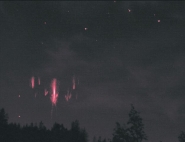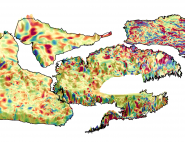Satellites
a constellation of orbiting compasses
On each of the satellites of the Swarm mission, the magnetic field is measured by a combination of three instruments: a Vector Field Magnetometer (VFM), to measure the components of the magnetic field along three axes perpendicular to each other; a star-tracker camera (STR), to calculate the attitude of the field in space; and an Absolute Scalar Magnetometer (ASM), to measure the strength of the magnetic field with extreme accuracy.
Orbiting compasses
Each of the satellites in the Swarm constellation carries a set of instruments comparable to a three-dimensional compass, capable of providing accurate measurements of both the strength and direction of the magnetic field. In addition, an accelerometer and an instrument for measuring the electrical field provide information on the state of the ionospheric environment through which they are travelling.
Why a constellation?
At the start of their life cycle in orbit, the three satellites will be relatively close to one another. Two of them fly in tandem at the same altitude (initially about 460 km) at an inclination of 87.35°; this orbit will decay naturally to an altitude of about 300 km at the end of their mission.
The third satellite is on a higher orbit (530 km at the start of the mission), with a slightly different inclination (87.95°).
The orbits of the satellites drift, with the result that the higher satellite will cross the trajectory of the other two at an angle of 90° in the course of the third year of the mission. Data will therefore be acquired simultaneously at different altitudes and local times, which will help to determine the effects of the different sources of the magnetic field.
A novel design
The three Swarm satellites have a trapezoidal shape, which is unusual for satellites, with a long boom deployed once they are in orbit. This original design resolves several issues: it reduces aerodynamic drag in these low orbits, makes the payload as compact as possible so that three satellites can be loaded into the fairing of the Rockot launcher, and also satisfies the requirements concerning magnetic properties inherent to the mission.
Developed on behalf of ESA by an industrial consortium led by EADS-Astrium GmbH, each satellite is about 9 m long, including the boom, and has a leading surface area of about 1 m2, in order to reduce aerodynamic drag and the quantity of Freon propellant necessary to keep it at its station. The boom points away from the direction of flight. This is because the Electric Field Instrument (EFI), located on the front of the satellite, must be able to probe the ionospheric plasma without any disruption from the satellite's wake.
After the boom is deployed, the satellite will no longer have any moving parts. The solar panels in particular are fixed, so as not to disturb the measurements taken by the accelerometer installed in the centre of the satellite.
Lastly, each of the Absolute Scalar Magnetometers (ASMs) has been installed at the tip of the boom, so as to be as far as possible from any magnetic disturbance generated by the equipment in the body of the satellite. The optical bench supporting the Vector Field Magnetometer (VFM), as well as the three star trackers, are mounted halfway along the boom.
Launch and beginning of the life-cycle
The Swarm constellation was put into orbit by a Rockot launcher from the Plesetsk cosmodrome in northern Russia, with simultaneous separation of all three satellites.
The European Space Operations Centre (ESOC), at Darmstadt in Germany, will supervise the mission via the principal receiving station at Kiruna in Sweden (other stations will also be used at the beginning of the life-cycle). The critical launch and early orbit phase will last about three days, during which the booms will be deployed and the satellites units switched on. The different scientific instruments will then be activated one after the other.
The formal in-flight acceptance process, lasting about three months, will verify that everything is working correctly at the expected levels of performance. The European Space Research Institute (ESRIN), at Frascati in Italy, will manage and distribute the scientific data, with processing and archiving being done in the UK.


